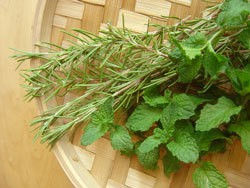The leaves of most herbs will appear limp and discolored after being frozen, and are not suitable for use as garnishes. However, they are still excellent when used in soups, sauces, salad dressings and cooked dishes. Seeds and flowers are best preserved by drying. Harvest leaves at the peak of growth, just before the plants starts to flower. Parsley, chervil and savory should be harvested while leaves are still young and tender.

Wash, drain and pat dry with paper towels. Strip leaves from stems, discarding any that show signs of disease or damage. Chop leaves or leave them whole as desired.
Freezer containers should be moisture and vapor resistant and should not be prone to cracking or breaking at low temperatures. Containers should provide protection against absorbing flavors or odors and should be easy to label. Suitable packaging for freezing includes freezer-grade plastic bags, rigid plastic containers or glass containers and ice cube trays.
At 0ºF, leaves will last up to 1 year and butters and pastes will last up to 6 months.
Leaves and pastes can be added directly to dishes without thawing. Thaw herb butter in the refrigerator or at room temperature.
Herbs that make great pastes include chervil, cilantro, dill, fennel, marjoram, mint, parsley, rosemary, sage, savory and tarragon.
Fresh herbs should be used or processes as quickly as possible after harvesting. Pastes and butters will last up to 3 months in the refrigerator. Warning: Pastes made from garlic and oil should be used immediately and not stored due to danger from Clostridium botulinum.

Add your voice! Click below to comment. ThriftyFun is powered by your wisdom!